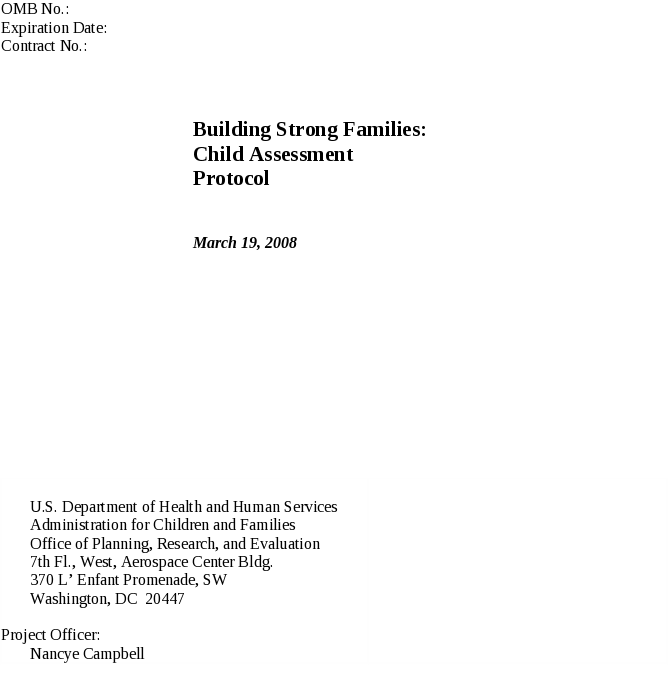Building Strong Families 36 Month Follow-Up Instrument #2: Child Direct Assessment
Building Strong Families (BSF) Demonstration and Evaluation - Impact Study Second Follow-up
BSF Instrument #2 - Child Assessment Protocol - 3-18-08
Building Strong Families 36 Month Follow-Up Instrument #2: Child Direct Assessment
OMB: 0970-0344

DIRECT ASSESSMENT OF CHILD DEVELOPMENT
The child assessment will be conducted using the Peabody Picture Vocabulary Test, Fourth Edition (PPVT-4; Dunn and Dunn 2006) and Test de Vocabulario en Imagenes Peabody (TVIP, Dunn, Padilla, Lugo, and Dunn 1986) and the Walk-the-Line Protocol.
The Peabody Picture Vocabulary Test, Fourth Edition (PPVT-4) is a norm-referenced standardized test designed to assess children’s receptive vocabulary. An assessor presents a series of words, ranging from easy to difficult, each accompanied by a picture plate consisting of four drawings. The child indicates which drawing best represents the target word. When the level of difficulty becomes too great (as demonstrated by the child’s incorrect responses to 8 items in a set of 12), the assessor ends the test. The reliability and validity of the PPVT-4 has been established for a wide range of ages, from 2½ through adulthood. A Spanish version, the Test de Vocabulario en Imagenes Peabody (TVIP), is available. Both versions of the assessment have been used in large-scale research projects, including assessing children at 36 months in the Early Head Start Research Evaluation Project and in the Fragile Families and Child Wellbeing Study, both of which involved large samples of children that have similar socio-demographic characteristics to the children in BSF.
REFERENCES
Dunn, L. M., and L. M. Dunn. Peabody Picture Vocabulary Test, Fourth Edition. “Examiner’s Manual and Norms Booklet.” Circle Pines, MN: American Guidance Service, 2006.
Dunn, L. M., E. R. Padilla, D. E., Lugo, and L. M. Dunn. “Test de Vocabulario en Imagenes Peabody.” Circle Pines, MN: American Guidance Service, 1986.
Walk the Line Protocol
MATERIALS: Roll of painters tape, 6 foot tape measure, stopwatch, large stickers |
INTRODUCTION: Now, we’re going to pretend this is a balance beam. Can you stand on the sticker right here? I’d like you to walk the balance beam, but don’t start until I say go. Okay?
(Ahora vamos a pretender que ésta es una barra de equilibrio. ¿Puedes pararte aquí, en la calcomania? Quisiera que camines por la barra de equilibrio, pero no empieces hasta que diga vamos. ¿Okay?)
ONCE THE CHILD IS IN POSITION, SAY: Ready? (Listo(a))
START WATCH AS YOU SAY: Go. (Vamos.)
WHEN THE CHILD STEPS OFF THE END OF THE TAPE, SAY: Okay. (Okay.)
STOP WATCH AS YOU SAY OKAY.
IF CHILD STARTS WALKING BEFORE YOU ARE READY, SAY: Hold on. Wait until I say go.
(Espera hasta que diga vamos.)
PROBE: IF CHILD RUNS, SKIPS, OR HOPS ON THE LINE, DO NOT CORRECT THE CHILD.
-
TRIAL1. RECORD CHILD’S TIME HERE: | | MINUTES | | |.| | | SECONDS
TRIAL1a. WAS CHILD ABLE TO STAY ON THE LINE…
1 ALMOST ALL OF THE TIME
2 MOST OF THE TIME
3 ONLY A LITTLE OF THE TIME
4 HARDLY AT ALL
r REFUSED
TRIAL1n. NOTES:

TRIAL2. Okay, let’s try that again. Let’s see how slow you can walk the balance beam. Okay?
(Okay, vamos a intentarlo de nuevo. Déjame ver que tan lento puedes caminar sobre la barra de equilibrio. Okay)
ONCE THE CHILD IS IN POSITION, SAY: Ready? (Listo(a)?)
START WATCH AS YOU SAY: Go. (Vamos.)
WHEN THE CHILD STEPS OFF THE END OF THE TAPE, SAY: Okay. (Okay.)
STOP WATCH AS YOU SAY OKAY.
IF CHILD STARTS WALKING BEFORE YOU ARE READY, SAY: Hold on. Wait until I say go.
(Espera hasta que diga vamos.)
PROBE: IF CHILD RUNS, SKIPS, OR HOPS ON THE LINE, DO NOT CORRECT THE CHILD.
-
TRIAL2. RECORD CHILD’S TIME HERE: | | MINUTES | | |.| | | SECONDS
TRIAL2a. WAS CHILD ABLE TO STAY ON THE LINE…
1 ALMOST ALL OF THE TIME
2 MOST OF THE TIME
3 ONLY A LITTLE OF THE TIME
4 HARDLY AT ALL
r REFUSED
TRIAL2n. NOTES:

TRIAL3. Okay, I want you to do it one more time, as slooow as you can go.
(Okay, quiero que lo hagas una vez más, tan leeeeento como puedas.)
INTERVIEWER: DRAW OUT AND EMPHASIZE THE WORD ‘SLOW.’
ONCE THE CHILD IS IN POSITION, SAY: Ready? (Listo(a)?)
START WATCH AS YOU SAY: Go. (Vamos.)
WHEN THE CHILD STEPS OFF THE END OF THE TAPE, SAY: Okay. (Okay.)
STOP WATCH AS YOU SAY OKAY.
IF CHILD STARTS WALKING BEFORE YOU ARE READY, SAY: Hold on. Wait until I say go.
(Espera hasta que diga vamos.)
PROBE: IF CHILD RUNS, SKIPS, OR HOPS ON THE LINE, DO NOT CORRECT THE CHILD.
-
TRIAL3. RECORD CHILD’S TIME HERE: | | MINUTES | | |.| | | SECONDS
TRIAL3a. WAS CHILD ABLE TO STAY ON THE LINE…
1 ALMOST ALL OF THE TIME
2 MOST OF THE TIME
3 ONLY A LITTLE OF THE TIME
4 HARDLY AT ALL
r REFUSED
TRIAL3n. NOTES:
| File Type | application/msword |
| File Title | DIRECT ASSESSMENT OF CHILD DEVELOPMENT |
| Author | Seth F. Chamberlain |
| Last Modified By | USER |
| File Modified | 2008-03-19 |
| File Created | 2008-03-19 |
© 2025 OMB.report | Privacy Policy